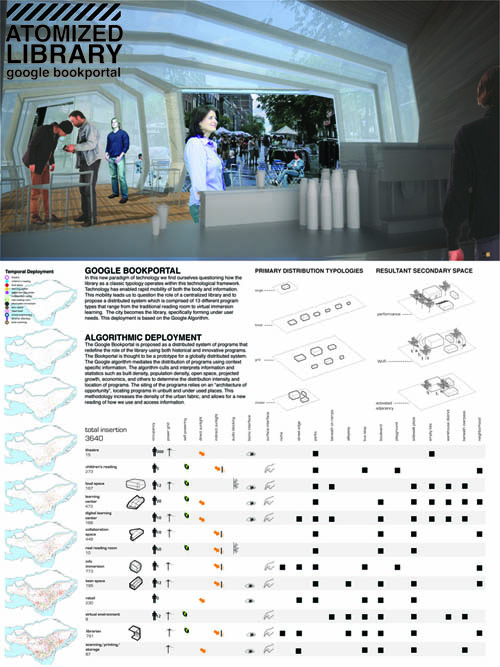
[Image: The "Atomized Library" by Duncan Young and Brett Walters].
For a recent studio at the California College of the Arts (CCA) in San Francisco, taught by Douglas Burnham of envelope A+D, students Duncan Young and Brett Walters produced what they call "The Atomized Library." It was produced as part of an overall studio exploring the space of the public library in an age of rapidly changing information storage.

[Image: The "Atomized Library" by Duncan Young and Brett Walters].
The basic idea was to scatter smaller information spaces throughout the city: buildings, kiosks, cafes, computer labs, public-access WiFi envelopes, media production centers, "teen spaces," public meeting rooms, and more. Importantly, though, the entire point of Young's investigation was to ask what libraries might look like if information was no longer accessed through books.

[Image: The "Atomized Library" by Duncan Young and Brett Walters].
"This methodology," Young and Walters write, "increases the density of the urban fabric, and allows for a new reading of how we use and access information." His units would be particularly well-suited, he suggests, for "unbuilt and under-used" urban sites.

[Image: The "Atomized Library" by Duncan Young and Brett Walters].
Think of it as a network of partially prefab, rapidly deployable, plug-in, book-less micro-libraries, with potential for global distribution. EasyLibrary, perhaps.
In fact, it raises an interesting question: when it comes to public libraries, whether we're referring to New York City or Ciudade del Este, what is the architectural equivalent of One Laptop Per Child? Is the future of the community library a modular shed, or has an entire building type been made obsolete by handheld devices?
Larger versions of these images are available on Flickr.
No comments:
Post a Comment